Dan Morton
A Fixture
Wikipedia (excerpts)
Portugal during World War I
From Wikipedia, the free encyclopedia
Jump to: navigation, search
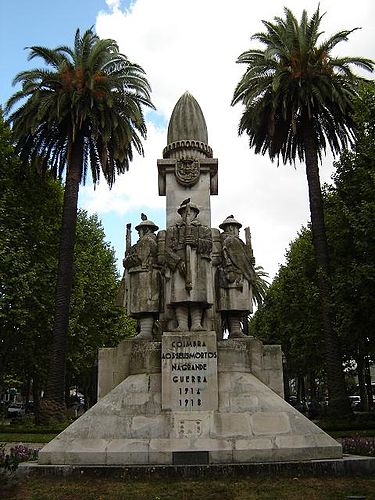
Monument to the Portuguese soldiers who died in World War I in Coimbra, Portugal
Portugal did not initially form part of the system of alliances involved in World War I and thus initially kept its neutrality. However, tensions between Germany and Portugal arose because of German U-boat warfare, which sought to blockade the United Kingdom, at the time the most important market for Portuguese products. Clashes also occurred with German troops in the south of Portuguese Angola in 1914 and 1915 (see German campaign in Angola).
Initially, both the Portuguese and the German governments officially stuck to neutrality. Unofficially, there were many hostile engagements between the countries. Portugal wanted to comply with British requests and protect its colonies in Africa. Ultimately, tensions resulted in war between Portugal and Germany being declared, first by the latter.
Approximately 12,000 Portuguese troops died during the course of World War I, including Africans serving in its armed forces.[1][2] Civilian deaths exceeded the prewar level by 220,000: 82,000 caused by food shortages and 138,000 by the Spanish flu.
1914
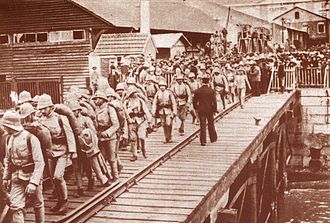
Portuguese troops embarking to Angola.
When Portugal complies with the British request to confiscate the German ships interned in Portuguese ports, Germany reacts by declaring war on Portugal, thus forcing the Portuguese officially into the war.
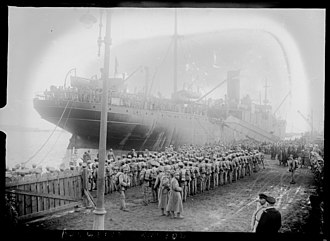
Portuguese troops disembarking at Brest.
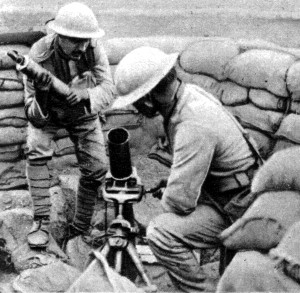
Portuguese troops loading the Stokes Mortar.
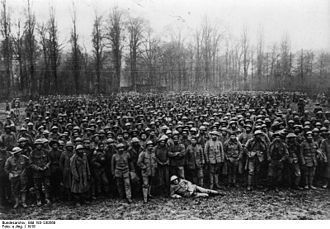
Portuguese prisoners-of-war in 1918.
Portugal during World War I
From Wikipedia, the free encyclopedia
Jump to: navigation, search

Monument to the Portuguese soldiers who died in World War I in Coimbra, Portugal
Portugal did not initially form part of the system of alliances involved in World War I and thus initially kept its neutrality. However, tensions between Germany and Portugal arose because of German U-boat warfare, which sought to blockade the United Kingdom, at the time the most important market for Portuguese products. Clashes also occurred with German troops in the south of Portuguese Angola in 1914 and 1915 (see German campaign in Angola).
Initially, both the Portuguese and the German governments officially stuck to neutrality. Unofficially, there were many hostile engagements between the countries. Portugal wanted to comply with British requests and protect its colonies in Africa. Ultimately, tensions resulted in war between Portugal and Germany being declared, first by the latter.
Approximately 12,000 Portuguese troops died during the course of World War I, including Africans serving in its armed forces.[1][2] Civilian deaths exceeded the prewar level by 220,000: 82,000 caused by food shortages and 138,000 by the Spanish flu.
1914

Portuguese troops embarking to Angola.
- July: The German and British Empires secretly negotiate about a possible dismemberment of Portuguese Angola;[4] in such a case, most of the land would fall into the hands of the Germans. Angola-Bund had been founded in 1912, a German organization promoting the takeover.
- August to September: Skirmishes occur between German and Portuguese colonial troops in Africa, and the Germans instigate tribal revolts.
- September: The Portuguese government sends reinforcements to the southern border of Angola. After the war breaks out, the border between German South West Africa and Angola remains open. The Germans hope to supply food and possibly even arms through it. However, the Portuguese colonial government is hostile and tries to stop all of the trade. A few German nationals in Angola are interned.
- October: 1600 troops arrive in Portuguese Angola, and 1527 troops arrive in Mozambique from Portugal, transported by British ships.[5]
- November:1543 troops arrive in Portuguese Mozambique, commanded by Moura Mendes. The second force is tasked to recapture the Kionga Triangle from the Germans.
When Portugal complies with the British request to confiscate the German ships interned in Portuguese ports, Germany reacts by declaring war on Portugal, thus forcing the Portuguese officially into the war.
- February 23: Following a British request, Portugal interns 36 German and Austro-Hungarian ships in Lisbon.
- March 9: Germany declares war on Portugal, followed by Portugal declaring war on Germany and starting to organise Portuguese troops to go to the Western Front. Shortly afterward, Portugal begins closing its consulates in the Ottoman Empire. (The Ottomans do not have any representation in Portugal, and Portugal and Bulgaria have no international relations of any kind.)[6]
- March 15: Austria-Hungary declares war on Portugal.
- June 9: Afonso Costa (Finance Minister) and Augusto Soares participate in an Allied Economic Conference in which the Allies decide that as a condition for peace, Germany would have to return the territories of Alsace-Lorraine to France (occupied since 1871) and Kionga in Portuguese Mozambique to Portugal (occupied since 1894).
- July 15: The British government formally invites Portugal to take an active part in the military actions of the Allies.
- July 22: The Portuguese Expeditionary Corps (Corpo Expedicionário Português, CEP), with 30,000 soldiers, is established in Tancos, Portugal, under the command of General Norton de Matos.
- August 7: The Portuguese Parliament accepts the participation of Portugal in the war, following the invitation of the British government. The Portuguese war effort reaches 55,000 infantry soldiers, plus 1,000 artillerymen, to be sent to France, 4,000 soldiers per month, to man 12 km of battlefront. Only the first two divisions reach France, as the shipping of American troops drastically reduces the Allies' transportation capacity. At the same time, Portugal fields forces in its African colonies: in Mozambique, to defend the colony from German colonial forces, and in the south of Angola, against native unrest instigated by the Germans.
- December 3: The German U-boat, SM U-38, captained by Max Valentiner, enters Funchal harbour in Madeira and torpedoes and sinks 3 ships, CS Dacia (1,856 tons),[7] SS Kanguroo (2,493 tons)[8] and Surprise (680 tons).[9] The commander of the French gunboat, Surprise, and 34 of her crew (7 Portuguese) die in the attack. The Dacia, a British cable laying vessel,[10] which had previously undertaken war work off the coast of Casablanca and Dakar, is in the process of diverting the German South American cable into Brest, France. Following the attack, the Germans proceed to bombard Funchal for 2 hours from a range of about 3 kilometres (2 mi). Batteries on Madeira return fire and eventually force the Germans to withdraw.
- December 26:The French government asks Portugal to send artillery crews to France to operate 20 to 30 heavy artillery batteries.

Portuguese troops disembarking at Brest.
- A few Portuguese troops are sent to New Forest, England to help with the timber shortage, working with the Canadian Forestry Corps. Today the area is known as the Portuguese Fireplace.
- January 3: A convention with Britain regulates Portuguese participation in the Western Front. Portuguese troops of the CEP to be integrated in the BEF (British Expeditionary Force).
- January 7: The Independent Heavy Artillery Corps (Corpo de Artilharia Pesada Independente, CAPI) is created to respond to the French request for artillery crews. Under the Portuguese Superior Command, this unit would operate 25 heavy artillery batteries.
- February 2: The first Portuguese troops arrive at the port of Brest, in Brittany, France.
- February 23: The second contingent of the CEP leaves for France.
- April 4 The Portuguese troops arrive at the front. The first Portuguese casualty is Private António Gonçalves Curado, killed in action.
- May 30: The First Infantry Brigade of the CEP First Division occupies a sector at the battle front.
- June 4: Germans attack the sector defended by the First Brigade.
- June 16: Second Infantry Brigade occupies another sector on the battle front.
- July 10: CEP First Division assumed responsibility of its part of the Portuguese sector on the battle front. It is subordinated to the XI Corps of the British Army, under the command of General Richard Haking. CEP Third Infantry Brigade occupies a sector on the front.
- September 23: The Fourth Brigade, known as the Brigade of Minho (Brigada do Minho), part of the Second Division, reaches the front.
- October 17: The first Portuguese CAPI artillery soldiers, representing Portugal's direct support to the French war effort, arrive in France. They are designated by the French as the Corps d'artillerie lourde portugais (CALP).
- November 5: Portuguese command assumes responsibility for its sector in the front. Until then, it had been under the command of General Henry Horne's British First Army.
- Late 1917: In Portuguese Mozambique, German officer Paul von Lettow-Vorbeck, enters the colony from nearby German East Africa after a series of long running battles with numerically superior British forces.
- December 12: 2 German U-boats, SM U-156 and SM U-157 (captained by Max Valentiner) again bombard Funchal, Madeira. The attack lasts around 30 min, and 40 120 mm (4.7 in) and 150 mm (5.9 in) shells are fired. There are 3 fatalities and 17 wounded, In addition, a number of houses and Santa Clara Church are hit.
- December 17: German U-boat SM U-156 stops and scuttles the Portuguese ship Açoriano (a wooden three-masted schooner) southeast of the Azores.
- December 26: German U-boat SM U-157 (captained by Max Valentiner) sinks the Portuguese ship Lidia[11] in the Azores.

Portuguese troops loading the Stokes Mortar.
- February 17: German U-boat SM U-157 (captained by Max Valentiner) sinks the Portuguese ship Estrella de Bissao off the coast of South Africa.
- March 16: The Portuguese artillery batteries enter in action.
- March 27: A German offensive restrains the Portuguese soldiers from being released. As a third Portuguese Division is never sent to France, the Portuguese Army receives no reinforcements at all. Portuguese soldiers have to serve in the battle front for long periods and are thus among the most exhausted men in the front.
- April 6: The conditions of the Portuguese soldiers become so difficult that the British finally decide to release the Portuguese. The CEP is supposed to be reorganised, the First Division going to the rear as a reserve force and the Second Division becoming part of the Eleventh Corps of the British Army, under General Haking's command. Haking visits the Portuguese troops and decides to send the Second Division to the rear from April 9, which would never happen. The Germans attack the British lines, forcing them to retreat about 60 km. Instead of being released, the Portuguese troops have to fight off the German offensive on its sector.

Portuguese prisoners-of-war in 1918.
- April 9: The Battle of La Lys, as it becomes known in Portugal, or the Operation Georgette, or Battle of Estaires to the British, starts with a heavy artillery barrage from the Germans, followed by a German offensive with intensive use of lethal gas. The German Sixth Army deploys eight divisions (about 100,000 men), supported by intensive artillery fire. Against the force, the Portuguese have 20,000 soldiers and 88 guns. As a result, the Second Division is annihilated during the battle. The Portuguese CEP loses 327 officers and 7,098 soldiers, about 35% of its effective fighting capacity. The survivors are sent to the rear, some of the units being integrated into the British Army later on. During this battle, one of the most courageous acts in Portuguese history is perpetrated, as private Aníbal Milhais (also known as "Soldado Milhões" ["A Soldier as good as a million others" in his commanding officer's words]) defends the retreating allied forces with nothing but his machine gun, allowing them to fall back and regroup. Once he runs out of bullets, he escapes the battlefield. After defeating two German regiments and forcing the remaining German forces to go around him (they find it impossible to defeat what they believe to be an heavily armed post), he gets lost along the way, having to eat nothing but the sweet almonds his family had sent him from Portugal for three days. Lost and exhausted, he is able to rescue a Scottish major from drowning in a swamp. The major leads him to the Allied camp and tells of Milhais's deeds.
- July: General Tomás António Garcia Rosado is appointed as the new Commanding Chief of the remaining CEP.
- July: German forces, under von Lettow-Vorbeck, capture Namakura/Nhamacurra, in Portuguese East Africa and seize important arms and supplies for his force after similar smaller successes against Portuguese outposts had already helped reprovision his force.[12]
- July 4: CEP First Division was subordinated to the British Fifth Army, commanded by General William Birdwood.
- August 25: General Garcia Rosado assumes command of the CEP in France. The German U-boat SM U-157 sinks the Portuguese ship Gloria, 50 kilometres (30 mi) from Porto Santo, Madeira Islands.
- September 22: German U-boat SM U-157 sinks the Portuguese ship Gaia, near the Azores.
- October 14: In the Action of 14 October 1918, Portuguese patrol boat NRP Augusto Castilho (commanded by Carvalho Araújo) is sunk by the German U-boat U-139 (commanded by Lothar von Arnauld de la Perière) after several hours of fighting.
- November 11: Germany accepts the armistice proposed by the Allies. The war ends.
Attachments
-
 Ammo holders.jpg8.9 KB
Ammo holders.jpg8.9 KB -
 Backpack.jpg11.2 KB
Backpack.jpg11.2 KB -
 Backpack-and-field-gear-of-Private.jpg159.3 KB
Backpack-and-field-gear-of-Private.jpg159.3 KB -
 Belt.jpg8 KB
Belt.jpg8 KB -
 Boot hob nail pattern.jpg7.3 KB
Boot hob nail pattern.jpg7.3 KB -
 Boots.jpg7.5 KB
Boots.jpg7.5 KB -
 Cap.jpg12.8 KB
Cap.jpg12.8 KB -
 Captain-of-Field-Artillery.jpg33.8 KB
Captain-of-Field-Artillery.jpg33.8 KB -
 Cavalry spurs.jpg8.8 KB
Cavalry spurs.jpg8.8 KB -
 Cloak and Great coat.jpg16 KB
Cloak and Great coat.jpg16 KB -
 Great coat.jpg15.4 KB
Great coat.jpg15.4 KB -
 Hats-and-uniforms.jpg150.4 KB
Hats-and-uniforms.jpg150.4 KB -
 helmet 1.jpg11.1 KB
helmet 1.jpg11.1 KB -
 shovel.jpg7.9 KB
shovel.jpg7.9 KB -
 Rank epaulette ribbons.jpg9.6 KB
Rank epaulette ribbons.jpg9.6 KB -
 Side-view-of-Private-in-field-gear.jpg38.3 KB
Side-view-of-Private-in-field-gear.jpg38.3 KB -
 Tunic 1.jpg13.3 KB
Tunic 1.jpg13.3 KB -
 Tunic 2.jpg12.3 KB
Tunic 2.jpg12.3 KB -
 Tunic 3.jpg15.8 KB
Tunic 3.jpg15.8 KB -
 Tunic 4.jpg13.7 KB
Tunic 4.jpg13.7 KB -
 Tunic 5.jpg13.6 KB
Tunic 5.jpg13.6 KB -
 Two-Portuguese-Infantrymen-1917.JPG49.7 KB
Two-Portuguese-Infantrymen-1917.JPG49.7 KB -
 water bottle.jpg8.8 KB
water bottle.jpg8.8 KB -
 Private-in-field-gear.jpg58.8 KB
Private-in-field-gear.jpg58.8 KB -
 Portugese-marine-infantry,-1915.jpg20.3 KB
Portugese-marine-infantry,-1915.jpg20.3 KB







